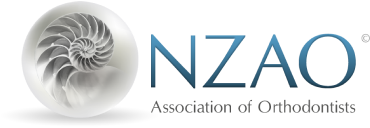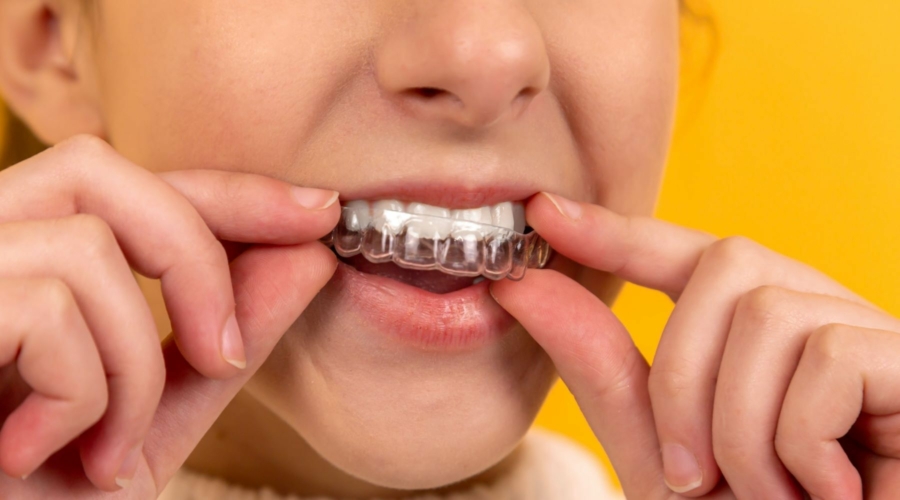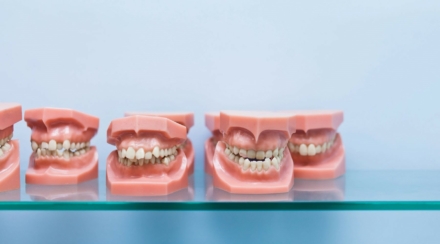Are you looking to achieve a straighter smile with orthodontic treatment? If so, find out here about the types of orthodontic treatment and adult braces available in New Zealand.
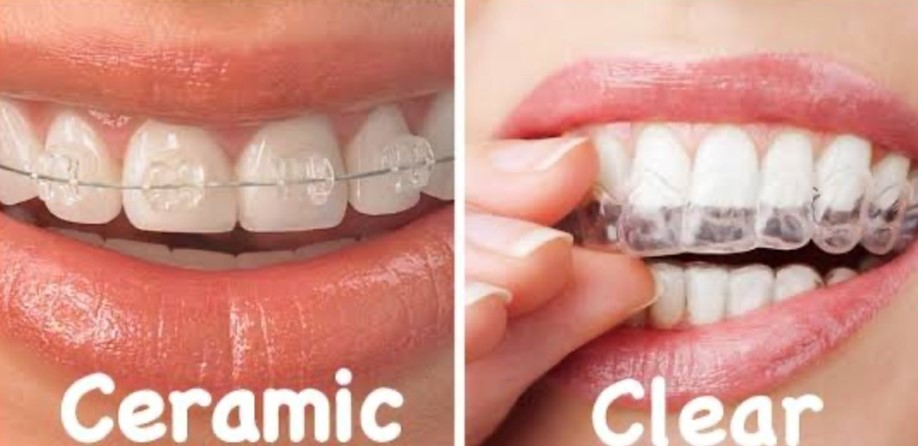
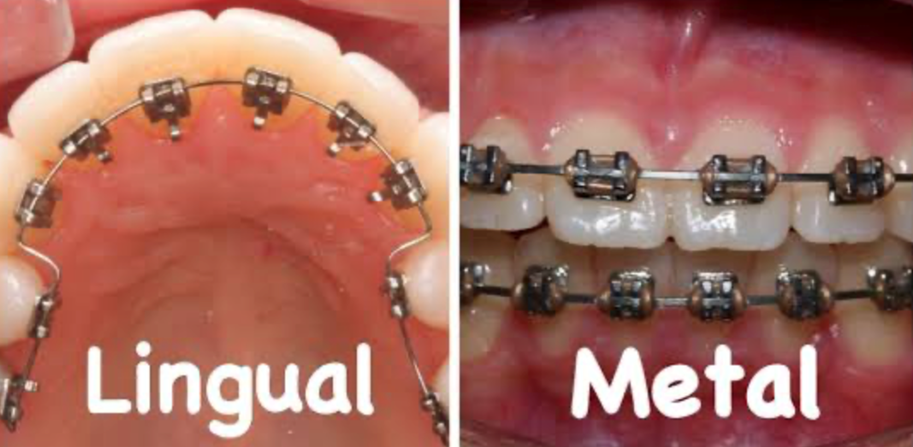
While orthodontic treatment is often associated with adolescents, it’s never too late to improve your smile. Orthodontists can offer invaluable expertise and guidance to individuals of all ages as to what orthodontic treatment is possible to give you a straighter smile.
Orthodontists are the most qualified and experienced specialists when it comes to achieving a beautiful smile. They possess the specialized training, knowledge and skills to assess your unique dental alignment needs and provide tailored solutions.
By consulting an orthodontist for orthodontic treatment, adults can enjoy the confidence-boosting benefits of a straighter smile, meticulously crafted by these skilled professionals.
From traditional metal braces to clear aligners, each option has its own unique benefits and considerations. In this comprehensive guide, we will explore the different types of adult orthodontic treatment in New Zealand, so you can make an informed decision about which option is best for you.
Traditional Metal Braces
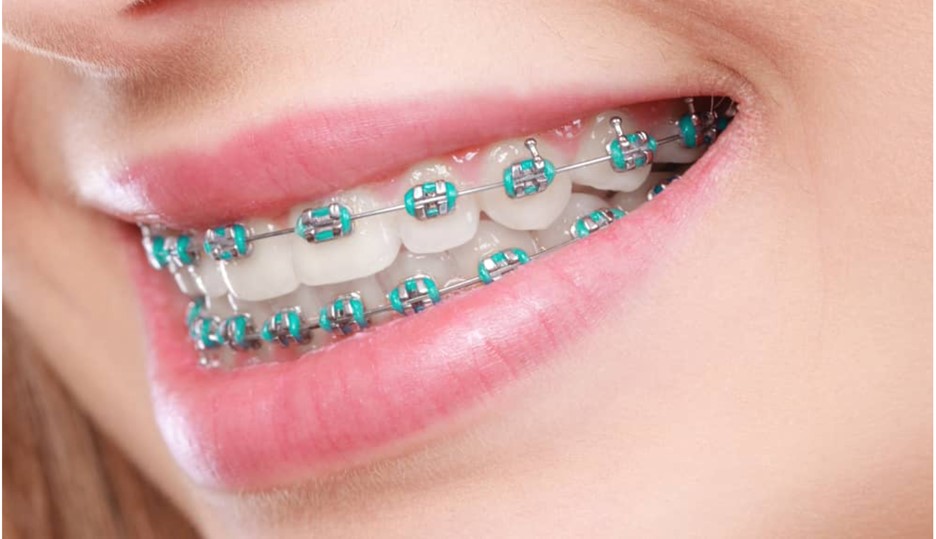
Traditional metal braces have been a popular choice for orthodontic treatment for over 100 years. They consist of metal brackets and bands that are attached to the teeth and connected by thin metal wires and elastomeric bands. While they are more obvious than some other options, they are robust and highly effective in achieving desired results.
How They Work
Metal braces exert gentle pressure on the teeth, gradually moving them into their correct positions. The wires and elastomeric bands are adjusted periodically by your orthodontist to ensure continual activation of the braces. Treatment duration can vary depending on the severity of the case, but it can typically range from 6 months to 3 years.
Pros:
- Effective: Metal braces are highly effective in treating complex orthodontic issues, including severe misalignments.
- Cost-Effective: Metal braces are often the most affordable option for orthodontic treatment.
- Suitable for All Ages: Metal braces can be used by adults and children alike.
- Ability to Customize: You can choose different coloured elastomeric bands to add a touch of personalization to your braces.
Cons:
- Visibility: Metal braces are the most noticeable type of braces, which can be a concern for adults who prefer a more discreet option.
- Discomfort: Initially, you may experience some pain and discomfort due to the pressure exerted by the braces on the teeth, and while the mouth and gums get used to the braces.
- Oral Hygiene Challenges: Cleaning around the brackets and wires takes time and can be challenging, requiring extra effort and diligence to maintain good oral hygiene.
- Dietary Restrictions: Certain foods, such as sticky or hard foods, may need to be avoided to prevent damage to the braces.
Joe was keen to have some orthodontic treatment to improve his smile. He works as a tradie and wanted something to fit with his workplace where it isn’t always possible to have clean hands to take appliances in and out of the mouth to eat. Also sometimes he admits he can be a bit forgetful so even though his orthodontist advised that he could have treatment with braces or removable clear aligners, he chose braces.
Metal braces have a long track record of successfully straightening teeth. However, specialist orthodontists offer a wide range of treatment options beyond traditional metal braces. Many adults prefer less conspicuous alternatives like clear aligners or ceramic braces.
Orthodontists excel in tailoring treatment plans to align with your preferences and lifestyle, ensuring that you receive orthodontic care that suits your unique needs.
Ceramic Braces
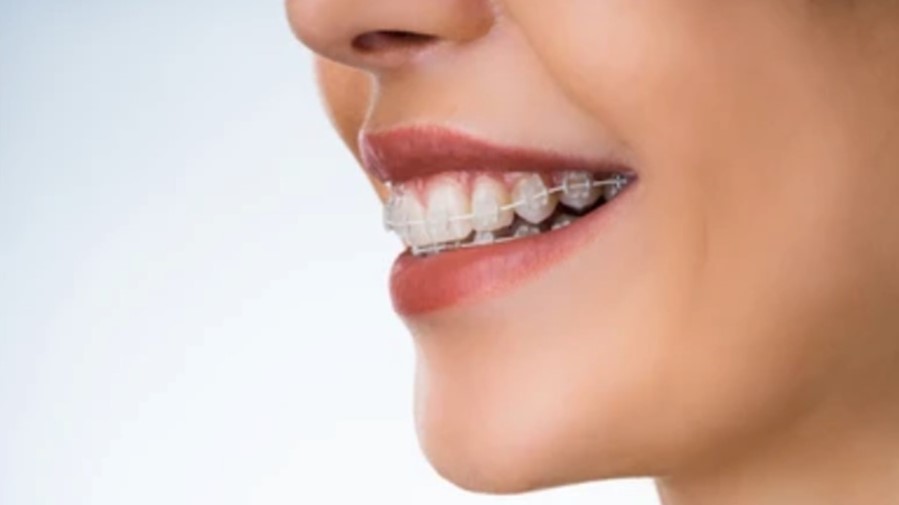
Ceramic braces offer a more discreet alternative to traditional metal braces. The braces are made of clear or tooth-coloured porcelain brackets, making them less noticeable.
How They Work
Similar to metal braces, ceramic braces use brackets and wires to gradually move the teeth into their desired positions. The main difference is the aesthetic appearance of the ceramic brackets, which blend in with the natural colour of your teeth making the braces less visible.
Pros:
- Aesthetic Appeal: Ceramic braces are less noticeable than traditional metal braces, making them a popular choice among adults.
- Effective: Ceramic braces can effectively treat a wide range of orthodontic issues.
- Customizable: Clear or colourful elastomeric bands can be used with ceramic braces, allowing for personalization.
Cons:
- Higher Cost: Ceramic braces tend to be more expensive than traditional metal braces.
- Potential for Staining: If clear elastomeric bands or modules are used to attach the wires to the ceramic braces, they can be prone to staining from eating some foods that are highly coloured, and if good oral hygiene is not maintained.
- Fragility: Ceramic brackets may be more prone to chipping or cracking compared to metal brackets.
Clear ceramic braces offer a discreet option for those who wish to straighten their teeth without drawing attention to their braces. However, if you are looking for an even more invisible treatment option, clear aligners such as Invisalign may be the right choice for you. Let’s explore clear aligners in the next section.
Clear Aligners
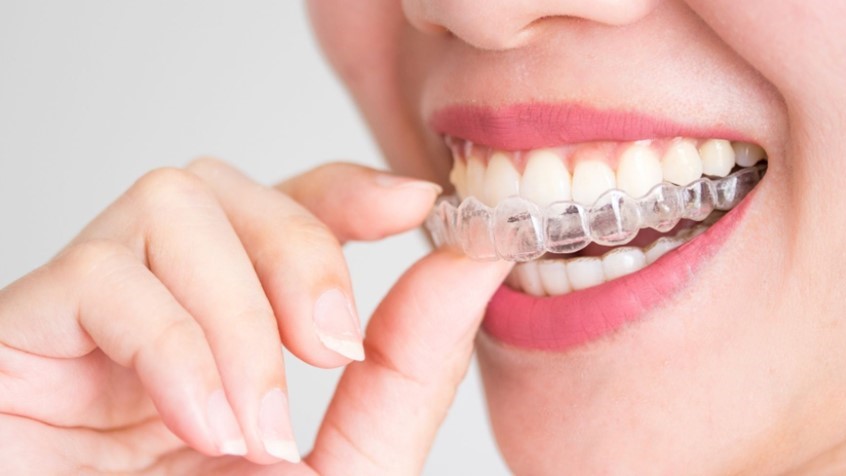
Clear aligners, such as Invisalign, Spark or Clarity, are a popular choice for adults seeking a nearly invisible orthodontic treatment. It utilizes a series of clear, removable aligners to gradually straighten the teeth.
Clear aligners should be fitted and supervised by a specialist orthodontist to ensure a personalized treatment plan. They will also monitor progress, and address any complications that may arise.
Orthodontists’ expertise in diagnosis, treatment planning and supervision is essential for achieving successful results and a properly aligned smile.
How They Work
Clear aligner treatment, like all orthodontic treatment, begins with an examination by your orthodontist, of your teeth, face and jaws, followed by diagnosis and formulation of a treatment plan to address your concerns. Once this is agreed upon a digital scan or impression of your teeth is used to create a 3D model of your mouth. Based on this model, a series of custom-made aligners are made to gradually shift your teeth into the desired position.
You wear each set of aligners for one to two weeks, removing them only to eat, drink, brush, and floss. As you progress through the series of aligners, your teeth will gradually move until they reach their final alignment.
Remote monitoring of your treatment progress by taking photos of your teeth with your smartphone and sending these to your orthodontist via an App such as Dental Monitoring may also be used to monitor the progress of your treatment and guide you as to when to change to the next aligner. This can mean fewer visits to the orthodontist’s office as your orthodontist checks your treatment progress remotely, and more convenience for you.

Chloe was studying at a University away from her hometown and was keen to start some orthodontic treatment to get the straighter smile that she had always wanted. Chloe and her Orthodontist came up with a plan to suit her needs which involved clear aligners and remote monitoring of her treatment progress. This includes visits to her Orthodontist when she was at home for the holiday breaks so that Chloe’s treatment could progress even though she was studying far away.
Pros:
- Invisibility: Clear aligners are virtually invisible, making them an ideal choice for adults who want a discreet treatment option.
- Removability: The ability to remove the aligners allows for easier oral hygiene maintenance and the freedom to eat and drink without restrictions.
- Comfort: Clear aligners are made of smooth plastic, reducing the likelihood of gum and cheek irritation. The adjustment increments of the teeth with each new aligner is generally much smaller than the increments when adjusting braces which also adds to the comfort of using aligners.
- Predictable Results: Clear aligner treatment uses advanced computer technology to plan and predict the movement of your teeth, providing accurate and predictable results.
Cons:
- Compliance: Clear aligners must be worn for at least 20-22 hours a day to achieve optimal results. Compliance is essential for the success of the treatment so if you don’t think you can comply with the wearing instructions then they will not be a suitable choice.
- Not Suitable for Complex Cases: Clear aligners may not be suitable for all severe orthodontic issues or cases requiring significant tooth rotation. It may be possible to have a hybrid mix of clear aligners and fixed braces – ask your orthodontist if this is an option.
- Speech Impediment: Some patients may experience a temporary lisp or speech impediment for a day or two during the initial adjustment period with clear aligners.
- Cost: Clear aligner treatment can be more expensive than traditional metal or ceramic braces
Regular supervision by an orthodontist is essential during clear aligner treatment. They will monitor your progress to ensure that your teeth are moving as planned. Adjustments may be made to your treatment plan if necessary to achieve the desired results.
However, if you are looking for an alternative to braces that are fixed to the teeth, lingual braces may be a suitable option for you. Let’s explore lingual braces in the next section.
Lingual Braces
Lingual braces are a hidden alternative to traditional braces. They are placed on the back side or tongue side of the teeth, making them virtually invisible from the front.
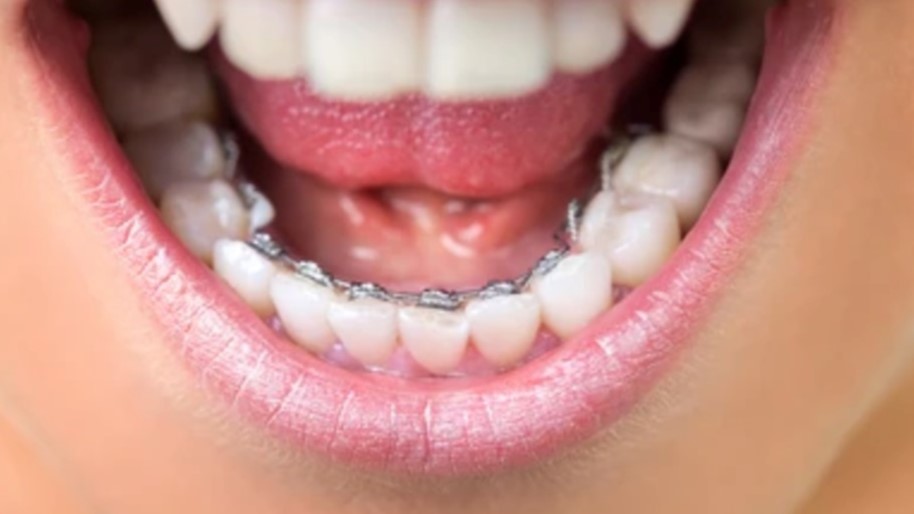
How They Work
Lingual braces function similarly to traditional metal braces, but the brackets and wires are attached to the back of the teeth. This allows for discreet treatment without compromising effectiveness.
Pros:
- Invisibility: Lingual braces are hidden behind the teeth, making them an excellent choice for individuals who want a discreet treatment option. However, you may be able to catch a glimpse of them when your mouth is open.
- Effective: Lingual braces can treat a wide range of orthodontic issues, including complex cases.
- Customized: Lingual braces are customized to fit the contours of your teeth, ensuring optimal comfort and results.
- No Staining: Since lingual braces are placed on the back of the teeth, there is no risk of visible staining.
Cons:
- Initial Discomfort: The placement of lingual braces may cause initial discomfort and affect speech until you get accustomed to them because of the close proximity to your tongue.
- Oral Hygiene Challenges: Cleaning around the lingual brackets and wires can be more challenging than with traditional braces.
- Cost: Lingual braces tend to be more expensive than traditional braces due to the customization and specialized placement.
- Adjustment time: Adjustment visits can be longer than traditional braces on the outside of the teeth.
Lingual braces offer a discreet alternative to traditional braces while providing effective orthodontic treatment.
Orthodontists are essential for the accurate placement of these braces, ensuring they effectively correct misalignments, and for ongoing adjustments to achieve the desired results while minimizing discomfort.
If you are looking for a braces option to avoid staining of elastomeric rings, then self-ligating braces might be worth considering. Let’s explore self-ligating braces in the next section.
Self-Ligating Braces
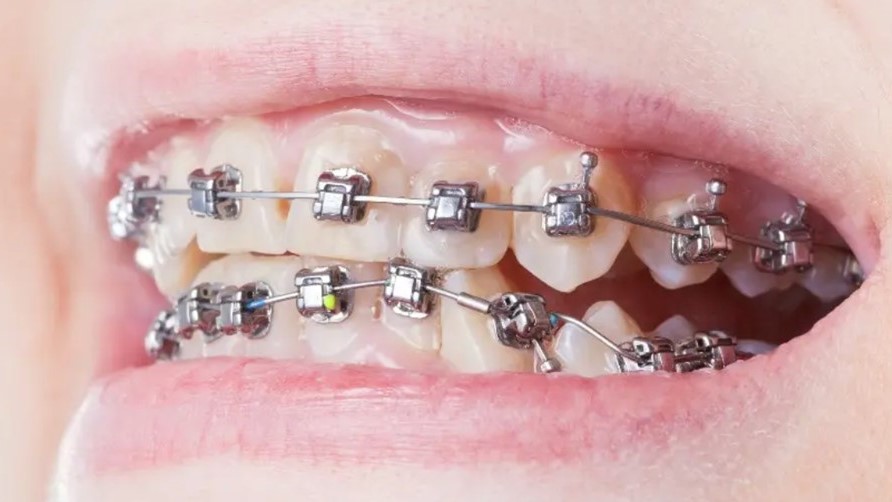
Self-ligating braces use a specialized bracket design that eliminates the need for elastomeric bands.
How They Work
Self-ligating braces use a sliding mechanism to hold the arch wire in place, which reportedly allows for more efficient and comfortable tooth movement. These braces may require fewer adjustments and maintenance appointments compared to traditional braces.
Pros:
- Shorter Treatment Time: Self-ligating braces may offer faster treatment times compared to traditional braces in the initial phase of orthodontic treatment when straightening teeth.
- Fewer Adjustments: Since self-ligating braces do not always require as regular adjustments as traditional braces, you may need fewer visits to the orthodontic practice.
- Easier Maintenance: Cleaning self-ligating braces is generally easier compared to traditional braces, as there are no elastomeric bands or ties to clean around.
- Reduced Discomfort: The sliding mechanism of self-ligating braces may reduce friction and discomfort associated with traditional braces.
Cons:
- Higher Cost: Self-ligating braces may be more expensive than traditional braces due to the specialized bracket system.
- Bracket failure: The sliding mechanism of self-ligating brackets can fail over time which may mean extra visits to replace the failed bracket(s).
- Not Suitable for All Cases: Self-ligating braces may not be suitable for severe orthodontic issues or cases requiring extensive tooth rotation.
Self-ligating braces offer an option for orthodontic treatment, which may mean faster initial treatment times and easier maintenance.
Orthodontists use their specialist knowledge and experience to customise the treatment plan, making necessary adjustments, and ensuring that self-ligating braces effectively address misalignments while providing the best possible results.
Cost of Adult Braces
The cost of adult braces in New Zealand can vary depending on several factors, including the type of braces, the complexity of your orthodontic issues, and the duration of treatment. It is essential to consult with an orthodontist to get an accurate estimate of the cost based on your specific needs.
In general, traditional metal braces tend to be the most affordable option, while clear aligners and lingual braces may be more expensive. Self-ligating braces and clear ceramic braces often fall in the mid-range in terms of cost.
It is worth noting that many orthodontic clinics offer flexible payment plans to help make orthodontic treatment more affordable. Be sure to discuss the financing options available with your orthodontist.
Read more: How much do braces cost?
Choosing the Right Type of Braces for You
Selecting the most suitable type of orthodontic treatment for your specific needs requires careful consideration. Here are some factors to keep in mind when making your decision:
- The severity of dental issues: Some types of braces are better suited for more complex cases, while others are suitable for milder misalignments.
- Aesthetic preferences: Consider how visible you want your braces to be during treatment. Options like ceramic braces and clear aligners like Invisalign offer more discreet options.
- Lifestyle and maintenance: Evaluate the level of commitment required for each type of braces, including cleaning, dietary restrictions, and follow-up appointments.
- Orthodontist’s recommendation: Consult with an experienced orthodontist who can assess your specific case and provide recommendations based on their expertise.
Remember, every individual’s orthodontic needs are unique, and what works for one person may not work for another. Schedule a consultation with an orthodontist to discuss your options and determine the best type of orthodontic treatment for you.
Conclusion
Achieving a straighter smile is within reach with the variety of adult orthodontic treatment options available in New Zealand. Whether you opt for traditional metal braces, ceramic braces, clear aligners, lingual braces, or self-ligating braces, each option can help you achieve the smile you desire.
Consider your specific dental needs, aesthetic preferences, and lifestyle factors when making your decision. Consult with an experienced orthodontist who can guide you towards the best treatment option for your unique case. With the right choice of orthodontic treatment, you can embark on your journey to a straighter and healthier smile.
Remember, orthodontic treatment is a long-term commitment, so be patient and consistent with your treatment plan. Orthodontists care about what is best for getting lasting results and are trained to deliver the best results over someone’s entire lifetime.
Enjoy the process of transforming your smile and embrace the positive impact it can have on your overall well-being.
For more information and personalized guidance, contact your local orthodontic clinic and schedule a consultation today. It’s easy. You don’t even need a referral.
Disclaimer: The information provided in this article is for educational purposes only and does not substitute professional advice. Please consult with a qualified orthodontist for personalized recommendations and treatment options.
